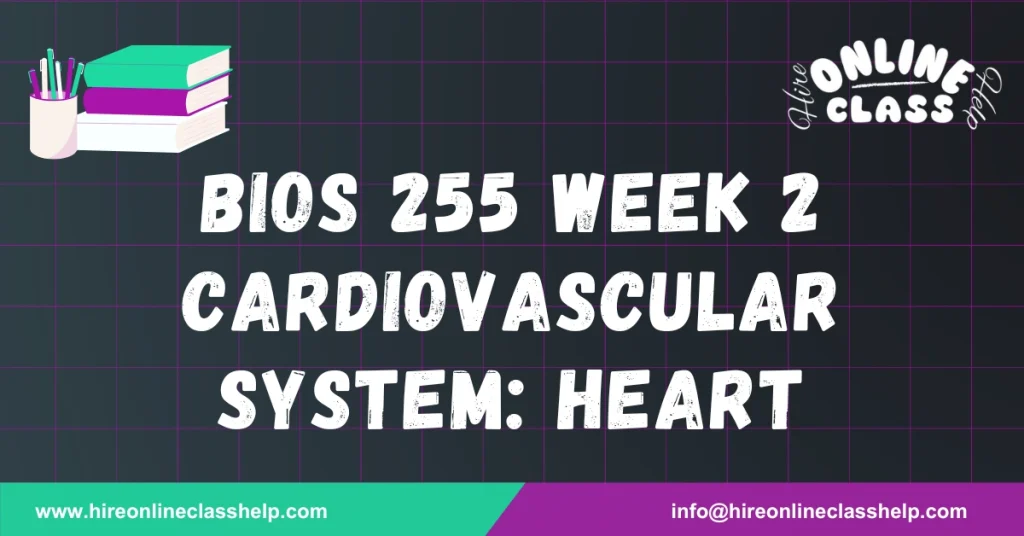






Name
Chamberlain University
BIOS-255: Anatomy & Physiology III with Lab
Prof. Name
Date
The cardiovascular system plays a crucial role in maintaining life by delivering oxygenated blood to the body and removing waste products. Central to this system is the heart, a powerful muscular pump that supports both systemic and pulmonary circulation. In this article, we will delve into the anatomy and function of the heart, explore blood flow through its chambers and valves, define critical terms like stroke volume and cardiac output, and discuss the heart’s response to exercise.
The heart is composed of four chambers, two atria (upper chambers) and two ventricles (lower chambers). The right atrium receives deoxygenated blood from the body via the superior and inferior vena cava, which then passes through the tricuspid valve into the right ventricle. From there, blood flows through the pulmonary valve into the pulmonary arteries, where it is transported to the lungs for oxygenation.
On the left side, oxygen-rich blood returns from the lungs to the left atrium via the pulmonary veins. The blood then moves through the mitral valve into the left ventricle. Finally, the left ventricle pumps this oxygenated blood through the aortic valve and into the aorta, distributing it to the rest of the body.
The heart’s valves play a critical role in ensuring one-way blood flow. The tricuspid, pulmonary, mitral, and aortic valves prevent backflow, allowing the heart to function efficiently.
Blood flow through the heart follows a specific sequence:
This continuous circulation ensures that all body cells receive oxygen and nutrients, while waste products like carbon dioxide are removed.
Stroke volume (SV) refers to the amount of blood ejected from a ventricle during each contraction. It is a key determinant of cardiac performance and varies with factors like body size, physical fitness, and health.
Cardiac output (CO) is the total volume of blood the heart pumps per minute. It can be calculated using the formula:
CO = SV × HR (Heart Rate)
Cardiac output is vital for assessing heart function and the body’s overall health. Increased heart rate or stroke volume will lead to an increase in cardiac output, allowing the body to meet higher oxygen demands during physical activity.
During exercise, the heart must work harder to meet the body’s increased oxygen and energy needs. The cardiovascular system responds by increasing heart rate, stroke volume, and cardiac output. Blood pressure may also rise temporarily to ensure adequate circulation to muscles and other tissues.
For instance, during intense physical activity, the heart pumps more blood by increasing stroke volume and heart rate. This allows more oxygen to reach active muscles and helps remove waste products like lactic acid. Understanding this dynamic response is crucial for athletes, trainers, and healthcare professionals in assessing cardiovascular fitness and performance.
Cardiac output and blood pressure are essential metrics for evaluating heart health. Cardiac output can be measured through various techniques, including echocardiography and Doppler ultrasound, which provide real-time data on heart function.
Blood pressure is typically measured using a sphygmomanometer, which records systolic and diastolic pressures. Systolic pressure represents the force exerted when the heart contracts, while diastolic pressure is the force exerted when the heart is at rest between beats. Maintaining healthy blood pressure levels is critical to avoiding cardiovascular issues like hypertension and heart disease.
In a cardiovascular lab setting, measurements of heart rate, stroke volume, and cardiac output during exercise provide insights into individual heart function. Consider the following data:
| Measurement | Subject A (Rest) | Subject A (Exercise) | Subject E (Rest) | Subject E (Exercise) |
|---|---|---|---|---|
| Heart Rate (HR) | 60 bpm | 150 bpm | 80 bpm | 200 bpm |
| Stroke Volume (SV) | 70 ml/beat | 120 ml/beat | 40 ml/beat | 35 ml/beat |
| Cardiac Output (CO) | 4.2 L/min | 18.0 L/min | 3.2 L/min | 7.0 L/min |
Subject A demonstrates a healthy cardiovascular response to exercise, with increased heart rate and stroke volume. However, Subject E exhibits lower stroke volume and cardiac output during exercise, suggesting potential heart issues such as aortic valve regurgitation. This condition forces the heart to work harder, increasing systolic pressure while diastolic pressure drops, a sign of inefficient blood flow.
From this cardiovascular lab, two key lessons emerge:
Understanding Healthy Cardiac Variables: Normal resting heart rate ranges from 60 to 70 bpm, stroke volume averages around 70 ml per beat, and cardiac output is typically 5 liters per minute at rest.
Doppler Effect Application in Cardiac Studies: The Doppler effect is critical in assessing blood flow and heart function. It describes how changes in frequency or wavelength occur as the source and observer move relative to each other—much like the change in sound of a passing ambulance.
The cardiovascular system, particularly the heart, is vital to life, constantly adjusting to meet the body’s demands. Understanding the anatomy of the heart, the process of blood circulation, and how factors like stroke volume and cardiac output function can offer valuable insights into heart health. Exercise places increased demands on the cardiovascular system, and monitoring heart function during physical activity can help detect potential heart conditions early. Maintaining cardiovascular health is essential for overall well-being, and regular exercise, along with proper health assessments, can ensure that the heart continues to function efficiently throughout life.